After making a return to the FAWSL, Tottenham Hotspur Women were hoping to make their mark on the league and become a mainstay for years to come. Just like Manchester United Women, Spurs are the new team on the block with the three established top teams far and above the rest. The key to any team’s first season is survival and stay in the top flight and to achieve this defensive solidarity becomes critical. Spurs have been anything but solid with a horrendous record conceding 18 goals in 11 games.
This tactical analysis scout report will be analysing their defensive frailties and understand where it’s going wrong for them. We will also analyse the tactics used to better understand if their style of play affects their defensive issues.
Style of play
Tottenham Hotspur Women usually line up in a structured 4-2-3-1 (26%) or 4-4-2 (24%). As we can see, Spurs have tried a number of formations but have relied upon the 4-2-3-1 and 4-4-2 for the majority of the campaign. The aim of the two formations is to create a solid foundation through the middle with an aim to keep a compact solid shape out of possession to then transition into counter-attacks. Certain pressing mechanisms will trigger them to counter-attack often when the opposition has committed numbers forward.
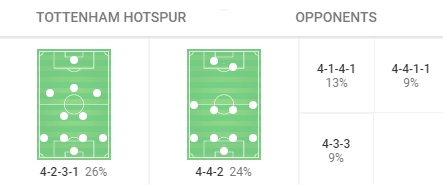
Their pressing starts from the front with the two centre-forwards applying pressure on the opposition defence to try and hurry them into passes. The hope is to create a mistake and pounce on the opportunity high up the pitch. The two wide players often tuck into a narrower position to create a compact block in the middle of the pitch if the opposition are stronger through the middle. However, they are flexible in staying wide and helping the full-backs against wide overloads. This helps to create defensive numerical superiority when the central midfielders shift across to the ball carrier’s side as we can see in the graphic below.
While on paper this setup seems to make sense for a team that is trying to establish themselves in the league, why do they leak so many goals? Using analysis, we will breakdown three specific aspects that are affecting their defensive system.
Tottenham Hotspur Women’s Shape & Pressing mechanics
To understand how the team presses we will need to examine and understand their shape. As is customary with any counter-attacking side, pressing is an integral part of a system. Usually, it starts from the front with the attacking players putting pressure on the opposition defenders limiting the space and time they have on the ball. For Tottenham Hotspur Women this stems from their rigid 4-4-2/4-2-3-1 setup. Juan Amoros and Karen Hills have tried to instil compactness and solidarity from the beginning and while the overall shape is good. They seem to be playing a low-block system allowing the opposition to come on to them before trying to dispossess them deep to counter-attack. However, the pressing becomes an issue once they go further back.
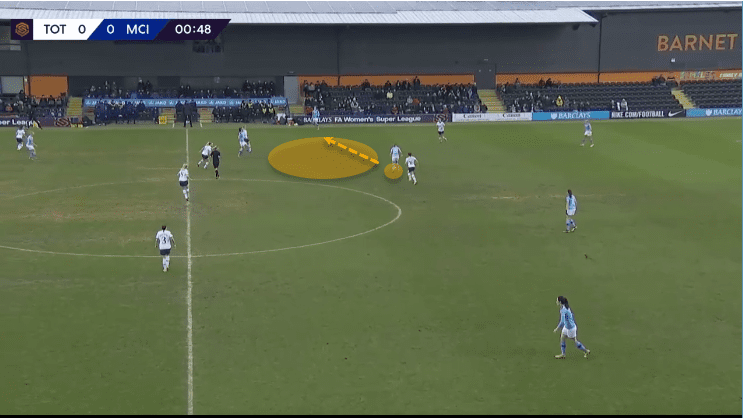
If we examine the game against Manchester City Women from a couple of weeks ago, they set up using a 4-4-2 formation. Within the first two minutes of play, it was easy to see how well structured they were with the two strikers putting pressure on Gemma Bonner and Steph Houghton. However, the problem started when Keira Walsh was able to receive possession without any pressure on her from midfield. The midfield four were too far off and needed to step up to press along with one of the strikers to close her down.
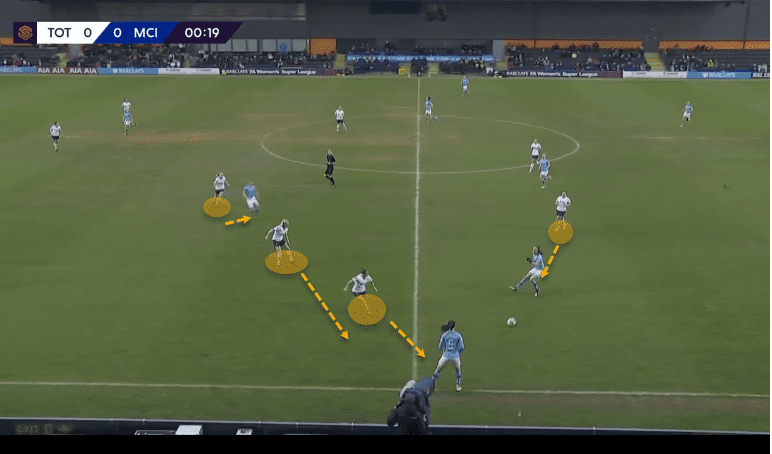
Allowing someone of her quality to dictate play is a recipe for disaster because of her ability to execute threatening forward passes. Stopping City’s movement high up the pitch will force them into playing against their strengths in transitioning the ball up through the central midfielders. Jill Scott and Caroline Weir are two energetic, dynamic ball carriers and passers that stopping them nullifies their attacking opportunities. Nonetheless, City eventually just passed the ball into the full-backs and sent a long pass down the flanks that was met by Lauren Hemp coming in off the left. While this move did not result in a goal, Spurs only began closing down the winger when the ball reached the box. At this point, City were able to break through.
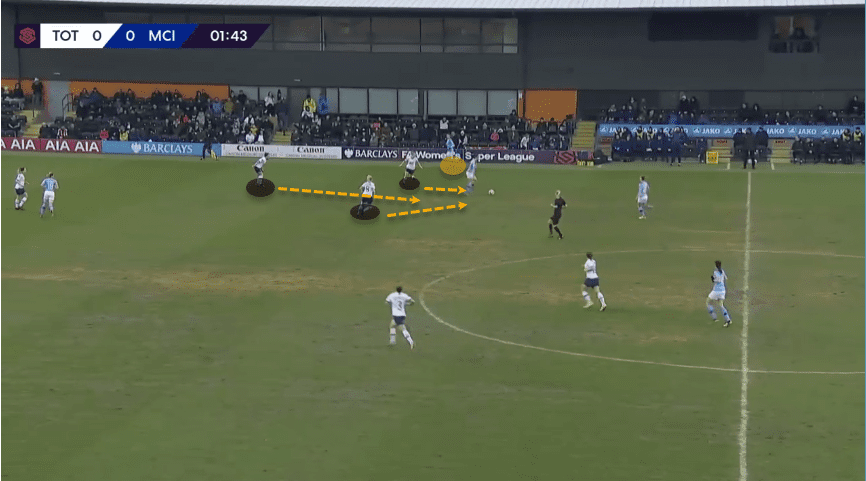
The build-up to the first goal conceded to City in the same game epitomised Spurs’ pressing issues. When Janine Beckie dribbled down the right flank and played the ball into Scott, the two central midfielders stood off her rather than trying to close her down.
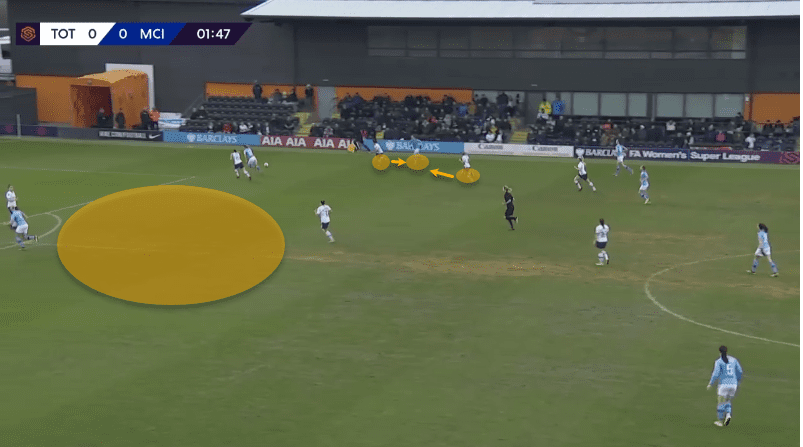
This allowed Scott to lay it off to Walsh who found Beckie free further forward. If the Spurs full-back was tighter on Beckie and one of the midfielders had closed down Scott it would have forced Walsh to find another passing option. Once Beckie laid off a one-touch pass into White’s path, City had an abundance of space to run into and create a goal-scoring opportunity. As we alluded to earlier, Spurs have conceded 19 goals in the FAWSL so far, with an xG against of 1.86 per 90.
If we look at the total xG conceded versus total goals conceded we get 22.32. What this means is Spurs have conceded more chances in their 12 games than goals conceded (19). This could come down to the quality of finishing from the other teams. Manchester City Women, Reading, Everton, and Arsenal have all scored two goals or more against Spurs which doesn’t make for good reading.
To top this off, Spurs have had 1.45 counter-attacks with 37.9% of them resulting in shots taken. In comparison, opponents have had 2.82 counter-attacks with 48.2% of them resulting in shots taken. It’s quite astonishing to see how teams have had more attacks on Tottenham Hotspur Women when their premise is to remain defensively compact and counter-attack.
1v1 Situations
Another issue that has come up on a regular basis has been Tottenham Hotspur Women’s ability to cope in 1v1 scenarios. Whilst teams need to be compact collectively, the individual quality must be present to negate certain situations. Many teams rely on their wide players – wingers and full-backs – to provide creativity and goal-scoring opportunities. Manchester City Women, Manchester United Women, Everton, and Arsenal are a handful of teams that have exceptionally talented wide players that are the source of their goals. This makes Spurs’ full-backs vitally important to prevent these teams from creating opportunities, especially in 1v1 situations. This begs the question, can Tottenham’s full-backs defend in these situations?
Well, the statistical differences are staggering. This season, Spurs have averaged 16.91 shots faced with 34.9% on target whereas the opposition have had 11.73 shots with 37.9% on target. The issue here is that Spurs are putting themselves into positions that leave their players isolated in their defensive third. The full-backs are especially exposed if the wide midfielders don’t track back quick enough or if they are tucked too far in for the opposition to exploit the halfspaces.
There are two types of wingers you’re most likely to see, one being a traditional speedy winger who bombs down the line and delivers crosses. The other being a playmaker who starts out wide and floats into a more central area, finding space between the lines. Spurs have had issues against both types of players. They are comfortable holding their shape whilst the opposition passes from side to side but once they progress possession into the final third quickly, is when Spurs start to face problems.
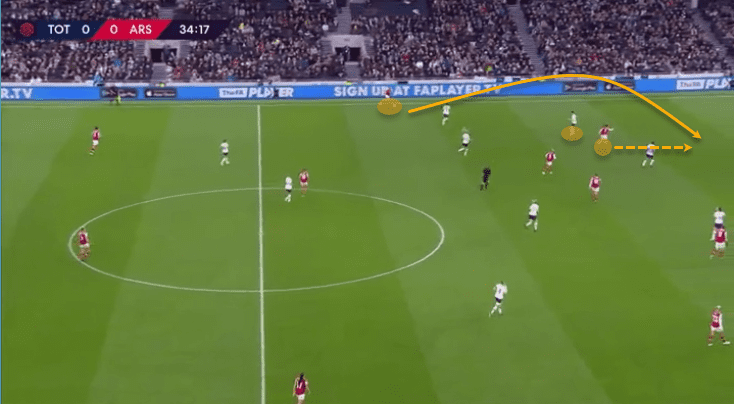
Above shows a situation where Spurs have held a good shape and line against Arsenal but because of the winger’s narrow position, Arsenal’s full-back has time to pick a pass. We can also see Danielle van de Donk running into the space between the Ashleigh Neville and Hannah Godfrey. Neville seems to be ball watching and totally misses Van de Donk’s position behind her. The Dutch international expertly runs onto Katie McCabe’s weighted pass and is now in a perfect position to cross the ball in. Both Neville and Siri Worm are susceptible to balls over the top. As we’ve seen against Arsenal in the above example, a combination of a lapse in concentration and poor positional awareness, allowed Arsenal in behind the defence. But, there is a silver lining amongst this.
While it may seem like Spurs find it hard to defend in isolated situations with the statistics seemingly backing this notion, Spurs’ full-backs can defend in 1v1 situations under certain circumstances. There have been moments where both Neville and Worm have successfully nullified the opposition wingers and full-backs and there is one common trait – they have both been in close proximity with numerical superiority. Every time they’ve been successful in stopping the opposition, the two full-backs have kept in close contact with the winger when close to their own penalty area.
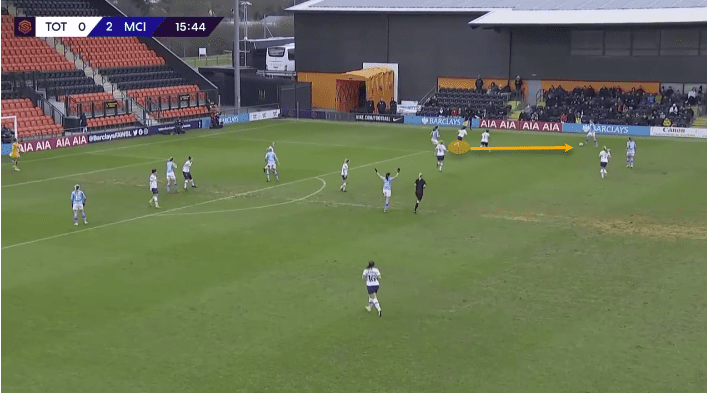
This example here will show Spurs’ ability to deal with individual duels. With City looking to build-up and work their way through Spurs’ defence, we can see Worm looking to rush out towards Beckie to close down the space. The issue we saw in the earlier example was Spurs were not closing down the opposition quick enough which gave them time to play around Spurs and score.
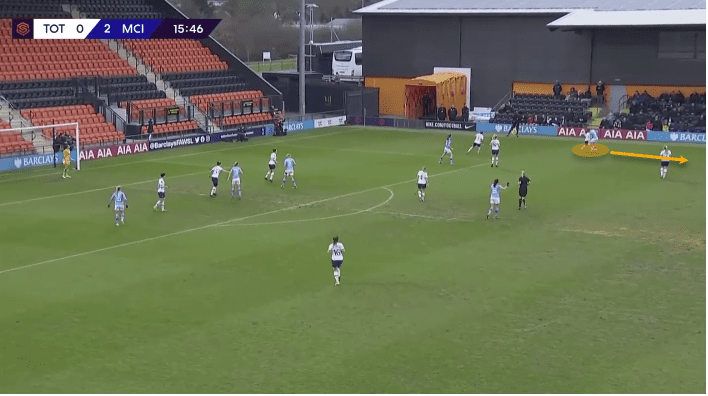
Worm’s quick reaction allows her to close down the right-back and dispossess her with City caught higher up the field giving Spurs an opportunity to counter-attack. The two Spurs full-backs may have their faults but they can seemingly defend in close-knit situations that happen in front of them. We’ve seen their weakness in dealing with balls in behind or over the top but as we’ve discussed earlier, that can be solved if Spurs change system.
How can they fix the problem?
A possible solution to stopping teams from counter-attacking and easily penetrating the team’s defence could lie in a change in formation. They currently utilise a 4-4-2 and 4-2-3-1 but that hasn’t worked out too well because of the reasons we’ve mentioned earlier. A change to a 3-5-2 system could prove fruitful to Spurs. The three-man formation has several benefits none more so than the increased presence in midfield from two to three.
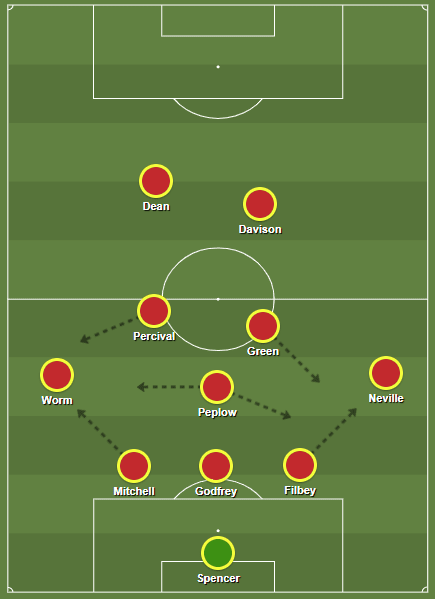
This can allow Spurs to create overloads in midfield and effectively counter-attack teams without leaving themselves exposed at the back. The third central defender also opens up the possibility of providing support to the wing-backs when they get overrun. Giving Worm and Neville numerical superiority and cover in behind can stop teams from making runs into the channels. We’ve seen the likes of Antonio Conte successfully implement this system at Inter Milan and Chelsea making his teams defensively sound making it extremely difficult for teams to breakdown. A change in tactics might be a move Spurs are in need of given the current state of affairs.
The other possible solution could be improving the performances at defensive midfield. The last couple of matches has seen Josie Green and Chloe Peplow string together a partnership, however, while both are adept at their roles there are certain holes. Green is an energetic presence in midfield and is a dynamic, box-to-box midfielder with her strongest trait being her tackling. The midfielder is able to dispossess her opponents but does dive into tackles either giving away a foul or missing the ball completely. Peplow plays a more conservative role and looks to screen the back four. While she has done a good job in patrolling the midfield area, she has been caught out of position enabling the opposition attacking midfielders to take advantage.
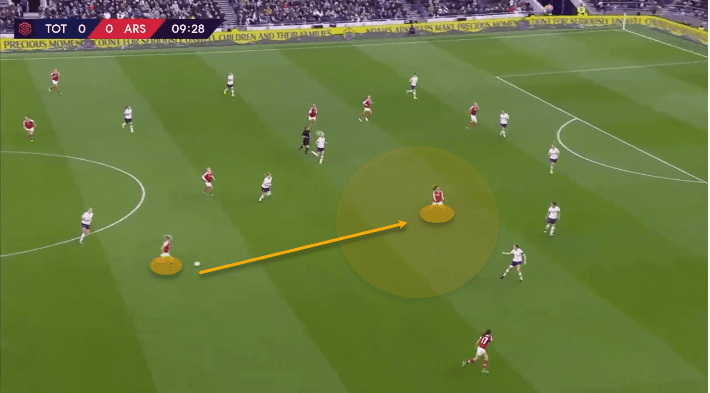
Against Arsenal, they would be expected to sit back and soak up the pressure to hit the Gunners on the counter-attack. However, as the image above shows, both central midfielders were too slow in getting back into position allowing Danielle van de Donk ample time and space to receive possession, turn and pick another pass. Players like Van de Donk, Kim Little, Ji So-yun, and Jill Scott will exploit that area of the pitch if not monitored at all times. The defensive midfield position is one the most crucial areas of the pitch which dictates how teams perform both defensively and offensively. If Peplow and Green are able to coordinate and act as a pendulum with a bit of discipline, Spurs could profit from better defensive stability.
Conclusion
Spurs have the foundation of a good team but need to remain disciplined when the opposition move deeper into their half. They hold a good shape and move as a unit effectively when the ball is in front of them, however, opponents take advantage of Spurs by playing quick, one-touch passing football to bypass the press and ultimately use the space given to them. The solutions could be a way to shore up any extra space and give Spurs the numerical advantage in the most dangerous areas of the pitch. Providing each side with support and an extra layer of protection will make Spurs tough to beat. Like Manchester City with Nick Cushing taking inspiration from Pep Guardiola, Amoros and Hills could look at Jose Mourinho and instil parts of his philosophy on their team.






Comments